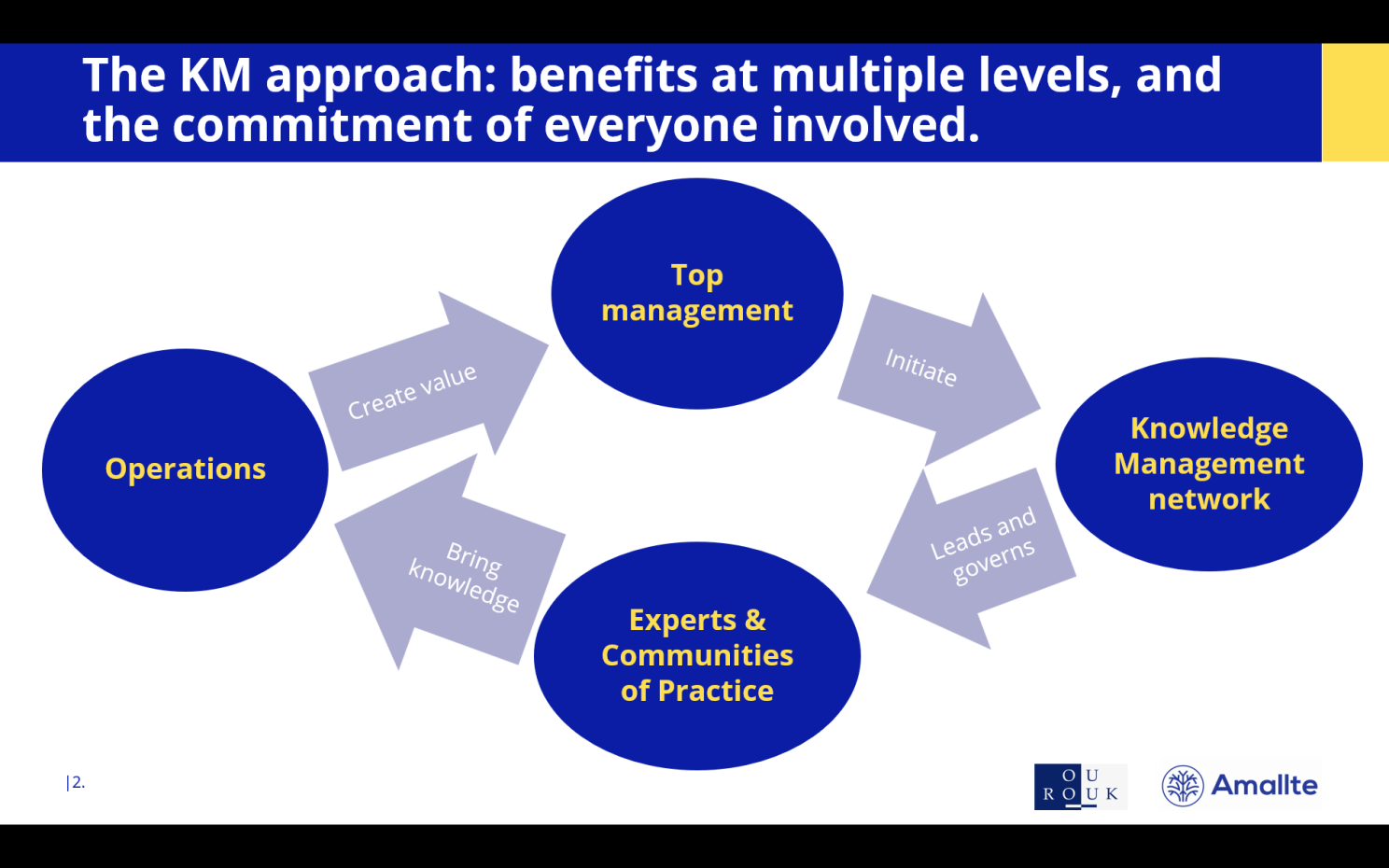Engaging Top Management in Knowledge Management: Key Strategies for Success
At a time when top management is facing up to the challenges of efficiency and innovation, we’d like to offer you some food for thought on the added value of a knowledge management (KM) approach to meeting these challenges.

Knowledge management (KM) is a process that valorizes professional knowledge, whatever its nature (academic, feedback, documentation, expertise…) and form (tacit/explicit), to create professional value.
Knowledge management is an approach, both local and global, that is built up in successive phases, involving the entire organization across the board. Despite the diversity of the issues at stake, whatever the activities concerned, these KM projects share common resources (management, new roles, platform, information governance), the coordination of which justifies a program-based approach, with sponsorship at top management level.
1 What questions does Top Management ask about KM?
As with any cross-functional approach, top management should be interested in a knowledge management (KM) initiative. And, as with any cross-functional, innovative approach, top management needs to combine its interest with critical reflection.
To get your CEO interested in KM, you need to answer a few simple questions:
- What strategic and operational issues does your proposed KM approach address?
- What are other organizations in our industry doing? Have you done any benchmarking?
- Does this approach fall within the scope of a standard? As you know it does (ISO 30401), how can we avoid the excesses of complying with ISO 9001?
- How can we mobilize operational managers and get them on board? What can be achieved in the short term?
- Will it be necessary to hire new staff, or more precisely, how can existing staff be redeployed, given that managing information is a matter of common sense for the CEO?
- Will the rise of artificial intelligence make knowledge management obsolete?
- Why prioritize KM over big data, dematerialization, the digital workplace or digital archiving?
- Should we invest in new tools, or more precisely, why can’t we use all those content management or collaborative tools (Microsoft, Google, etc.) we’ve already acquired?
- Can the KM approach provide a solution to our lack of governance of Microsoft Office, and now of collaborative workspaces and intranets?
- What metrics will we use to monitor this approach?
2 Some answers
The answers to these questions are straightforward, but require different developments in different contexts.
- Offensive issues (innovation, operational excellence, growth, etc.) and defensive issues (sustainability, service continuity, risk management, human resources and expert management, etc.) are common to all organizations, but priorities may differ.
- In every major domain of industry and services, it is now easy to identify benchmark organizations (for example, in France, over two hundred organizations have appointed a knowledge manager), and professional associations such as KMGN or SIKM are places to share experience.
- The mobilization of a given department/BU is a matter of relevance and opportunity analysis (Ourouk/Amallte is well versed in this exercise) via a mapping of critical knowledge and the most appropriate KM initiatives (community, return on experience, KM portal, webinar, internal Wikipedia, etc.).
- Yes, KM needs dedicated resources, because knowledge governance is not self-evident. Yes, internal resources can be redeployed, but they need serious training.
- No, Generative AI, still in its infancy, does not replace KM, but it is used by search engines to provide better results and to summarize tons of documents.
- KM is one aspect of digital transformation. The major solution providers (Microsoft, Google) offer KM tools, but the question is how to implement them.
- Existing collaborative tools can often be sufficient for first-wave KM; more powerful tools will become necessary as we mature, notably to facilitate search and automated processing to build a knowledge base.
- KM indicators are qualitative as much as quantitative, if not more so. The most important thing is to prove to the CEO, through concrete testimonials for example, that the KM system meets the organization’s challenges.

It is also possible to interest a CEO in KM by mentioning areas of usage or value creation that he or she is not aware of:
- the success of a merger/acquisition,
- talent retention,
- the organization’s reputation,
- making processes more agile.
KM is gradually deployed, usually through local initiatives supported by motivated players. With maturity, KM will move closer to the CEO and federate local initiatives. At this point, the question of the additional resources required will be easier to address.
Gonzague Chastenet de Gery & Louis-Pierre Guillaume
Further reading
- Effective Strategies to Secure Middle Management Commitment to Knowledge Management
- How to convince a knowledge worker to commit to a KM approach?
Next step
- Book an appointment for a free 45-minute diagnosis of your particular problem: https://www.amallte.com/Diag-EN



Trackbacks & Pingbacks
[…] Engaging Top Management in Knowledge Management: Key Strategies for Success […]
[…] Engaging Top Management in Knowledge Management: Key Strategies for Success […]
[…] How can you get your top management interested in knowledge management? […]
Leave a Reply
Want to join the discussion?Feel free to contribute!